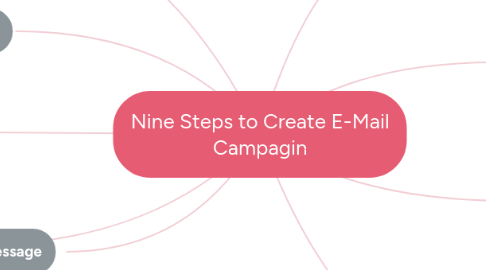
1. 1. Strategic planning
1.1. A company can use a promotional email to gain an immediate reaction or goal whether it be the user asking further questions about the product being promoted or the user purchasing the product right as they see it being promoted.
1.1.1. Newsletters can sit out and wait for a goal to be achieved. Important key indicators will play a part in whether the e-mail is opened, the user will continue bouncing onto their site and various pages in their site, or if they will forward that email to someone else.
2. 2. Definition of list
2.1. Users only receive e-mails if they have manually inserted their e-mail on the companies websites. Thus from that, companies will continuously send e-mails to only desired users who have subscribed to receive emails.
2.1.1. If a user gets annoyed by the constant e-mails they receive, they have the option to unsubscribe. Which then a company can collect through their database and see which e-mail was the last straw for the user.
3. 3. Creative execution
3.1. HTML e-mails are the more popular emails, they contain text as long as fun graphics that go along with their e-mail.
3.1.1. Plain text e-mails are just blank emails, as plain as it sounds. A company would use this method of e-mail to drive users for more action and interaction.
4. 4. Integration of campaign with other channels
4.1. If a company is promoting something in their e-mails, it should also be the headline on their website or it won't be emphasized as much.
4.1.1. Companies that don't have their promotional items displayed as the heading on their website, there is a lack of detail and effort.
5. 5. Personalization of the message
5.1. Depending on the user, companies can use their database to figure out whether they prefer HTML based e-mails or plain based e-mails and send one that suits their needs.
5.1.1. The company can also flush out the database and send their e-mails to the desired audience that would be most interested in the product they are promoting.
6. 6. Deployment
6.1. Companies also test the times to send out their e-mails, sometimes companies get more action if their e-mails are sent out during the day versus the evening, and vice versa.
6.1.1. It is also important that the companies e-mails do not be marked as spam for it then defeats the purpose of their e-mail.
7. 7. Interaction handling
7.1. Even confirmation e-mails are taken in account for how well the companies strategy and how nice the e-mail looks to the consumer.
7.1.1. These e-mails can also help promote other offers the company has. So, a user should open the confirmation e-mail not only to look for their tracking, etc., but also see if other products that they advertise look appealing to them as well.
8. 8. Generation of reports
8.1. Most companies use Google Analytics as their report site. The companies report the bounce rate, unsubscribe rate, open rate, anything, etc.
8.1.1. Unsubscribe rates are the most crucial to companies for it means that they are not fulfilling their task of promoting their item and getting the revenue and profit from their merchandise.
9. 9. Analysis of results
9.1. The company looks at the text, style, open rate, click through rates to determine how they will design their next e-mail in hopes for a higher outcome.
9.1.1. The most important part about creating the campaign e-mail is testing various types of e-mails the company has created and sending out the most popular in hopes that the rest of their users will like it as much as the test users.
